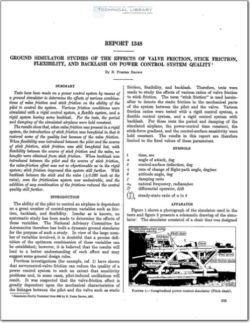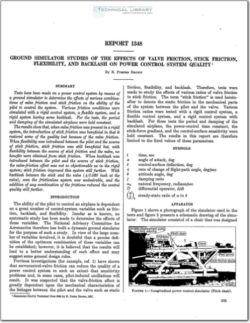NACA-Report-1348

- Version
- 139 Downloads
- 1.15 MB File Size
- 1 File Count
- December 4, 2015 Create Date
- December 4, 2015 Last Updated
National Advisory Committee for Aeronautics, Report - Ground Simulator Studies of the Effects of Valve Friction, Stick Friction, Flexibility and Backlash on Power Control System Quality

Tests have been made on a power control system by means of
a ground simulator to determine the ejects of various combina-
tions of valve friction and stick friction on the ability of the
pilot to control the system. Various friction conditions were
simulated with a rigid control system, a flexible system, and a
rigid system having some backlash. For the tests, the period
and damping of the simulated airplane were held constant.
The results show that, when valve friction was present in a rigid
system, the introduction of stick friction was beneficial in that it
restored some of the quality lost because of the valve friction.
When flavibility was introduced between the pilot and the source
of stick friction, stick friction was still beneficial but, with
fleitibility between the source of stick friction and the valve, no
benefits were obtained from stick friction. When backlash was
introduced between the pilot and the source of stick friction,
the valve-friction efiect was not so objectionable as in the rigid
system; stick friction improved this system still further. With
backlash between the stick and the valve (320.035 inch at the
valve), even the frictionless system was undesirable, and the
addition of any combination of the frictions reduced the control
quality still further.
The ability of the pilot to control an airplane is dependent
on a great number of control-system variables such as fric—
tion, backlash, and flexibility. Insofar as is known, no
systematic study has been made to determine the effects of
these variables. The National Advisory Committee for
Aeronautics therefore has built a dynamic ground simulator
for the purpose of such a study. In view of the large num—
ber of variables involved, it is doubtful that a precise defi—
nition of the optimum combination of these variables can
be established; however, it is believed that the results will
lead to a better understanding of each effect and may
suggest some general design rules.
Previous investigations (for example, ref. 1) have shown
that servocontrol—valve friction can reduce the quality of a
power control system to such an extent that sensitivity
problems and, in some cases, pilot-induced oscillations will
result. It was suspected that the valve-friction effect is
greatly dependent upon the mechanical characteristics of
the linkages between the pilot and the valve such as static
I Superscdes ‘NACA Technical Note was by B. Porter Brown, 1951.
| File | Action |
|---|---|
| naca-report-1348.pdf | Download |

Comment On This Post